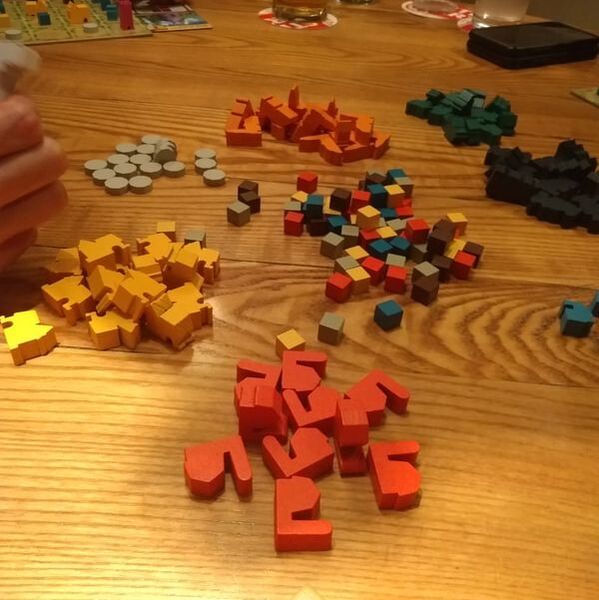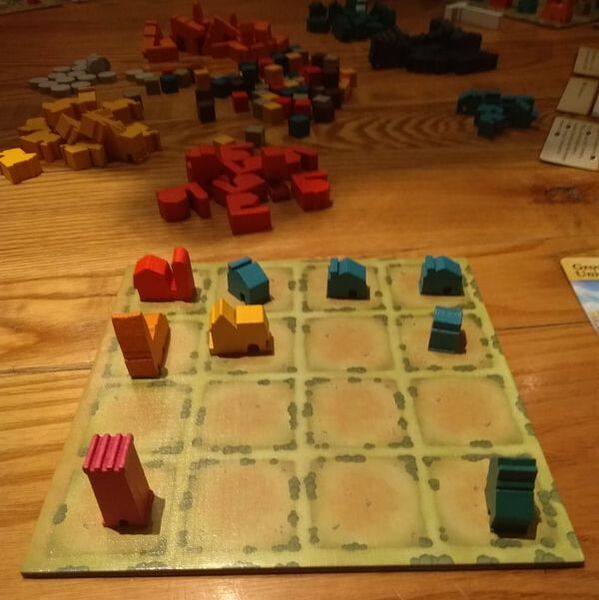|
7th May 2019 It's a Tuesday, so naturally that means gaming down at 'The Sove...' er.. wait? The Sovereign has its family dining area fully booked out and they didn't bother informing us? Marvellous! By that I mean crappy. So we need an alternative venue... It's a Tuesday, so naturally that means gaming down at... 'The Wheatshef' in Woking. The evening started off with 'Tiny Towns'. Tiny Towns has a plot about being tiny animals building a town. It's strange because it's a meaningless addition to the game. Yes, it's a game about building a town, but whether it's tiny or not makes no difference. What's in a game? Game board: Each player has their own 4x4 playing board, in Tiny Towns you are building your own individual town and not a collective town. Wooden cubes: Yes Tiny Towns is obviously a soulless cube pushing Euro. So the game comes with an abundance of wooden cubes in 5 glorious colours. Buildings: Tiny Towns is always played with exactly 7 different types of buildings, no more, no less. What these buildings are will change from game to game. But there are 7 different shaped and coloured wooden blocks used to depict what buildings are used in the game. Monuments: This is the 8th type of building in the game. Each player will have a single monument block to represent which monument they posses - all monuments are unique and generally confer some sort of bonus on the player Cards: The game has a stack of oversized cards that represent both normal buildings and monuments. Hammer: The game has a wooden hammer, used to represent who is the first player and thus also the round's 'master-builder'. So all the components are placed in the centre of the gaming area and each player takes a game board. The cards are used to determine which buildings will appear in this game. The cards need some explaining. Each of the 7 building types has 4 different cards (except the Cottage - there's only 1 cottage card).
Finally, there are the monument cards: 2 monument cards are dealt to each player at the start of each game. Each player will discard one monument and keep the other one (hidden until played). Each monument is unique, they can give you a 'one-off' or ongoing benefit. They can give you points. When played well, a monument can help you a lot. How's it play?
Constructing buildings is the name of the game. How is this achieved? Each building card will have a multicoloured 'tetris-like' shape on it. Generally this is always the same for each building type. Cottages always have 'L' shapes, yellow food producing buildings are always have a 2x2 square and green social buildings have a 'T' shape. However the colours of the shapes on the cards are different for each of the 4 types of each building. To construct a building, you must place cubes on your personal board that match the configuration as depicted on that card. For example: To build an Inn requires 3 blocks in a straight line and their colours must be 'yellow, grey and blue'. The inn can be built from left to right, or up or down. As long as the 3 cubes are in a straight line and the middle cube is grey and the end cubes are always yellow and blue, then a tavern can be built (if you choose). Then, to build it, the 3 cubes are removed from your board and a green building meeple is placed into one of the spaces vacated by the 3 cubes - and that's it. Well, that's not it, but that's a summary of the most important rule. So this is how a turn goes.
Endgame When a player can no longer place a cube on their board, they are eliminated from the game. Eventually they'll only be one player left and they can continue playing until they too cannot place any further cubes. Then scores are totted up and a winner is declared. Overall? So, thinking about this game. I feel that there are two distinct levels of play. The basic level of play involves maximising the placing of the cubes you receive. It is possible to place cubes in such a way that they can be used for more than one building. Especially since you do not have to construct a building if you have the cubes in the right place. This allows you to keep cubes 'in play' to be used for alternate buildings. It can give you strategies and options. Then there's the higher level of play. Looking at the choices of the other players and trying to anticipate their strategies. Not necessarily to try and mess with them, (You'll mess with the other players accidentally more than anything else) but just to improve your own strategies. Overall, I like Tiny Towns, it always gives you meaningful choices to make (Even if those choices are not entirely of your own making - which makes those decisions even more important!) and I think that's a good thing. Tiny Towns also has a mechanic that I've never seen before - I always like that. Play time is fairly brisk, a game seems to take no more than an hour. The first time I played Tiny Towns, everyone was up for a second game straightaway. The one significant criticism I have of Tiny Towns is that it has player elimination. That's something I don't like. Luckily it seems that when players are eliminated, it's close to the conclusion of a game. So, one grumble aside. Tiny Towns is a good enough game for me to get a copy of it.
0 Comments
Leave a Reply. |
AuthorI play, I paint. Archives
March 2024
Categories
All
|




 RSS Feed
RSS Feed
